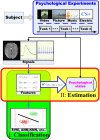Higher-order Multivariable Polynomial Regression to Estimate Human Affective States
- PMID: 26996254
- PMCID: PMC4800309
- DOI: 10.1038/srep23384
Higher-order Multivariable Polynomial Regression to Estimate Human Affective States
Abstract
From direct observations, facial, vocal, gestural, physiological, and central nervous signals, estimating human affective states through computational models such as multivariate linear-regression analysis, support vector regression, and artificial neural network, have been proposed in the past decade. In these models, linear models are generally lack of precision because of ignoring intrinsic nonlinearities of complex psychophysiological processes; and nonlinear models commonly adopt complicated algorithms. To improve accuracy and simplify model, we introduce a new computational modeling method named as higher-order multivariable polynomial regression to estimate human affective states. The study employs standardized pictures in the International Affective Picture System to induce thirty subjects' affective states, and obtains pure affective patterns of skin conductance as input variables to the higher-order multivariable polynomial model for predicting affective valence and arousal. Experimental results show that our method is able to obtain efficient correlation coefficients of 0.98 and 0.96 for estimation of affective valence and arousal, respectively. Moreover, the method may provide certain indirect evidences that valence and arousal have their brain's motivational circuit origins. Thus, the proposed method can serve as a novel one for efficiently estimating human affective states.
Conflict of interest statement
The authors declare no competing financial interests.
Figures








References
-
- Picard R. W. Affective computing 100–130 (MIT press: Cambridge,, 1997).
-
- Picard R. W., Vyzas E. & Healey J. Toward machine emotional intelligence: analysis of affective physiological state. IEEE Transactions on Pattern Analysis and Machine Intelligence 23, 1175–1191 (2001).
-
- Calvo R. A. & D’Mello S. Affect detection: An interdisciplinary review of models, methods, and their applications. IEEE Transactions on Affective Computing 1, 18–37 (2010).
-
- Schaaff K. & Schultz T. Towards an eeg-based emotion recognizer for humanoid robots. In Robot and Human Interactive Communication, 2009. RO-MAN 2009. The 18th IEEE International Symposium on, 792–796 (IEEE, 2009).
-
- Novak D., Mihelj M. & Munih M. A survey of methods for data fusion and system adaptation using autonomic nervous system responses in physiological computing. Interacting with Computers 24, 154–172 (2012).
Publication types
MeSH terms
LinkOut - more resources
Full Text Sources
Other Literature Sources
Miscellaneous

